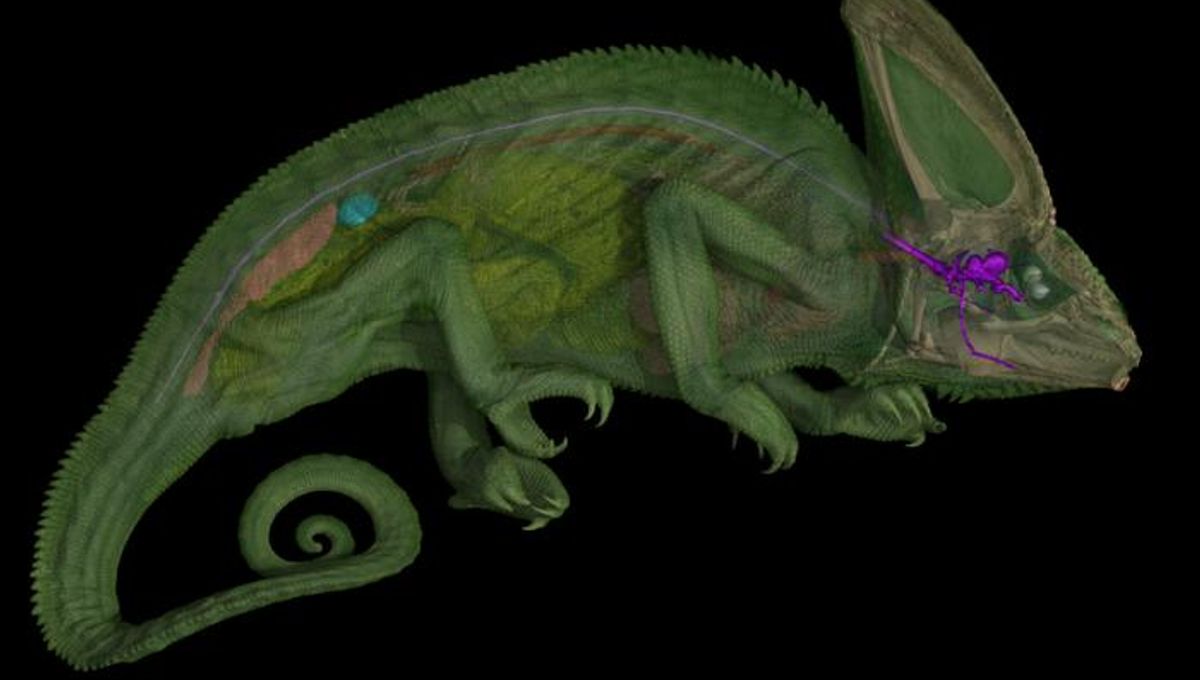
Chameleons have spiral optic nerves, CT scans and 3D modelling reveal. The discovery explains how the lizards can literally keep an eye out for prey in almost every direction, moving their eyeballs as if each has a mind of its own.
Chameleons are most famous for their capacity to mimic the colors of their environment, but the next best-known chameleon fact might be that they possess bulging eyes that move independently. Clearly their camouflage isn’t that good, because not only have humans spotted them for millennia, but even ancient Greek philosophers were aware of the way their eyeballs move, and sought to explain it.
Yet only now has the answer been revealed, in the form of a looping optic nerve unlike any of their reptile relatives.
“Chameleon eyes are like security cameras, moving in all directions,” said study author Dr Juan Daza of Sam Houston State University in a statement. “They move their eyes independently while scanning their environment to find prey. And the moment they find their prey, their eyes coordinate and go in one direction so they can calculate where to shoot their tongues.”
Daza and Dr Edward Stanley of the Florida Museum of Natural History performed CT scans of a minute leaf chameleon (Brookesia minima) and noticed the way the optic nerve coiled. They realized this was the solution to the mystery, but were unsure if it was already well known to others.
“I was surprised by the structure itself, but I was more surprised that nobody else had noticed it,” Daza said. “Chameleons are well studied, and people have been doing anatomical studies of them for a long time.”
Yet extensive searches of the scientific literature found no such report. The team even got old texts published before the modern peer-review system translated from Latin and other languages. Aristotle, with his usual talent for proclaiming the utterly wrong with supreme confidence, declared chameleons don’t have optic nerves at all. Their eyeballs connected directly to their brains, he pronounced, no doubt being accepted unquestioningly by ancient scholars.
Once Galileo had made challenging Aristotle all the rage in Italy, the Roman doctor Domenico Panaroli decided to check, and announced chameleons do have optic nerves. Unlike most animals, however, he claimed their nerves do not cross. Panaroli decided this direct connection was all that was needed to explain the eyes’ capacity to move independently. French anatomist Claude Perrault disagreed, and drew the chameleon’s optic nerves crossing.
Isaac Newton was sufficiently taken with Panaroli’s work that he promoted the idea in his trilogy Opticks, more famous for showing that white light is composed of many colors. The grip chameleons have on the public imagination was such that Newton mentioned them several times in the book, but unfortunately, he appears to have been unaware of Perrault’s correct study.
As Daza and Stanley’s team dug deeper, they discovered that in the mid-19th century, a drawing of the chameleon’s optic nerve by Johann Fischer came close to revealing the truth, showing a part of the coiled area, but the rest was out of shot, as it were, and no one thought to look. Even in 2015, a master’s thesis called the nerve “C-shaped”, which doesn’t really capture the truth.
All these scientists got things so wrong because they were chopping up dead chameleons, rather than scanning live ones. “Throughout history people have looked at chameleon eyes because they’re interesting,” Stanley said. “But if you physically dissect the animal, you lose information that can tell the full story.”
Having discovered the truth about one chameleon species, the authors needed to see if all members of the family are alike. Stanley’s own museum keeps a record of scans on many reptiles, including three chameleon species distantly enough related to be representative. All three have long, coiled optic nerves, the authors learned, unlike other lizards used for comparison.
The authors even explored how the nerve develops in veiled chameleon (Chamaeleo calyptratus) embryos, finding they start out straight, like other lizards, but gain enough of a loop by hatching for the eyes to operate independently. Cartoonist Amee Wilson might claim prior credit.
Possibly the third best-known chameleon fact is that they have tongues twice as long as their bodies to snatch prey out of the air. Since chameleons keep their tongues rolled up when not in use, perhaps we shouldn’t be surprised they do something similar with the nerves that carry signals from their eyeballs to their brains.
From an evolutionary perspective, however, the authors think the coiled nerves are a response to the chameleon’s stiff necks. Unable to turn to point their eyes where they need to see, they developed optic nerves in a shape seen in some insects, but has not been found in other vertebrates. Some fish, birds, and other lizards also show independent eye-movement, but as far as we know use different internal architecture.
“You can compare optic nerves with old phones,” Daza said. “The first phones just had a simple, straight cord attached to the headset, but then someone had the idea to coil the cord and give it more slack so people could walk farther while holding it. That’s what these animals are doing: They’re maximizing the range of motion of the eye by creating this coiled structure.” Anyone under 40 might wish to check a museum.
The study is published in Scientific Reports.
Source Link: We Finally Know How Chameleons' Bulging Eyes Can Point In Different Directions